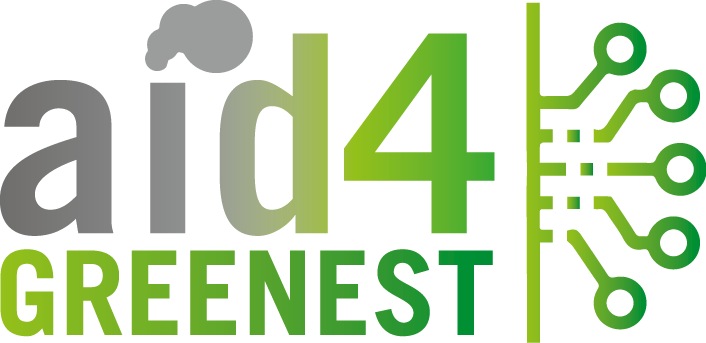Home » About
About AID4GREENEST
What is AID4GREENEST?
AID4GREENEST is a three-year (September 1, 2023 – August 31, 2026) Horizon Europe project with a budget of around 5 million EUR. It aims to develop a range of new Artificial Intelligence-based rapid characterisation methods and modeling tools for the steel sector. The scope of the tools developed through the AID4GREENEST project includes the steel design (chemistry and microstructure), process design (processing parameters), product design (processing and heat treatments), and product performance stages. The proposed tools are complemented by a roadmap designed to enable model-based innovation processes, from materials design to product development while considering industry needs: enhanced material quality, a reduction of carbon emissions, limiting waste generation, and reducing risks in the supply of critical raw materials. A consortium of 10 partners composed of leading European universities, research centers, steel companies, and a small enterprise steer the project.
Objectives
-
Objective 1
To develop three artificial intelligence-based chemistry-process-structure modelling tools that enable the design and processing of robust materials, and the development of production routes with reduced CO2 impact.
-
Objective 2
To develop a machine learning-based tool capable of predicting creep performance and a methodology for rapid generation of the relevant data based on accelerated creep testing. These tools will dramatically increase the efficiency of R&D activities concerning the creep performance of heat-resistant steels as well as the manufacturing process.
-
Objective 3
To develop a sequential model for predicting microstructure evolution during forging and quenching of meter-scale products and to design an improved methodology for the existing manufacturing processes with reduced environmental impact. The model will fully eliminate re-processing of defective manufactured meter-scale parts. It will also eliminate the conventional trial-and-error approaches of R&D tests that result in significant waste of energy, material, and expensive consumables.
-
Objective 4
To validate the developed artificial intelligence-based tools and characterisation methods using available data along with the data generated within the framework of AID4GREENEST.
-
Objective 5
To develop an artificial intelligence-based online platform for knowledge transfer and standardisation of characterisation methods and modelling tools. This online platform will serve as a forum for knowledge sharing including workflows, open access publications, standardisation or guidance documents and non-confidential data from microstructural and mechanical characterisation with automated AI-based annotation for new data.
-
Objective 6
To perform life cycle assessment and enable model-based innovation processes covering all stages from materials design to product development. A roadmap towards the adoption of model-based innovation processes, based in combining AI-based models and life cycle analysis methodology will be developed.
-
Objective 7
To disseminate and communicate results, create guiding criteria and guiding principles for the European industry. To ensure the market penetration of the project’s results by designing specific business models for their exploitation.
Significance and Impact
The development of advanced materials including high-strength steels is the key to boosting the development of the EU’s key strategic sectors. The use of advanced materials is crucial for different sectors such as Renewables, Space and Defence, E-mobility, and Energy among others. For the Renewables sector, the EU has set the ambitious target of reducing greenhouse gas emissions by 40 % by 2030. To achieve this decrease, new advanced materials and scalable manufacturing methods must be developed, since they represent 80 % of the technology component costs in the sector.
The current need for alloying materials in the high-tech steel sector is a critical issue particularly for the EU, since it is highly dependent on other countries in the supply of critical raw materials. This leaves the EU vulnerable as it is unable to control access/availability and price. Currently the dependent strategic sectors spend significant amounts per year on buying these alloying elements, an expenditure which is expected to increase in the future.
Hot Rolling of Steels
AID4GREENEST allows the steel industry to accelerate the decarburisation of the manufacturing of hot rolled steels with a martensitic matrix. With a total market size of about 5 million tonnes per year globally, these AHSSs make up only a small portion of the total flat carbon market (1800 million tonnes). However, redesigning existing grades (and hence existing tonnages) towards low CO2 versions represents several billions of euros worth of tonnage in absolute values. In addition, thanks to the excellent mechanical properties of martensitic steels, they are of particular interest to the flourishing market segments of yellow and green goods and heavy transport applications.
Forging and quenching
Steel will remain important for sector large-size forgings, mainly as elements of turbines and generators. Therefore, the optimisation of production (including energy-intensive heat treatment) will allow for a significant reduction of costs and environmental impact. Wind energy, as one of the important end users of meter-scale manufactured products, represents a great commitment to the future for the diversification and sustainability of the European energy system. According to EWEA, Europe installed 14,7 GW of new wind capacity in 2020 and could install around 105 GW over the next five years if governments adopt their promised measures to reach the targets set in their National Energy and Climate Change Plans. Nevertheless, the wind energy industry faces big challenges such as reducing technology costs. The levelized cost of energy is a key indicator of global competitiveness. In the case of offshore wind energy, the current strategic goal is to reduce prices from 10 c€/kWh in 2020 to 7c€/kWh in 2030 through improvements across the whole value chain. Therefore, achieving higher efficiency, long durability using sustainable steels, and lower costs in the manufacturing processes of components such as wind turbine shafts, are all essential factors in ensuring improved competitiveness. In this regard, increasing the efficiency and effectiveness of the materials and of the product and the manufacturing process for these fundamental components will have a significant positive effect in the sector: more reliable components at a reduced cost and reduced time to market.
Significance in critical materials supply
The current need for alloying materials in the high-tech steel sector is a critical issue particularly for the EU, since it is highly dependent on other countries in the supply of critical raw materials. This leaves the EU vulnerable as it is unable to control access/availability and price. Currently the dependent strategic sectors spend significant amounts per year on buying these alloying elements, an expenditure which is expected to increase in the future.


